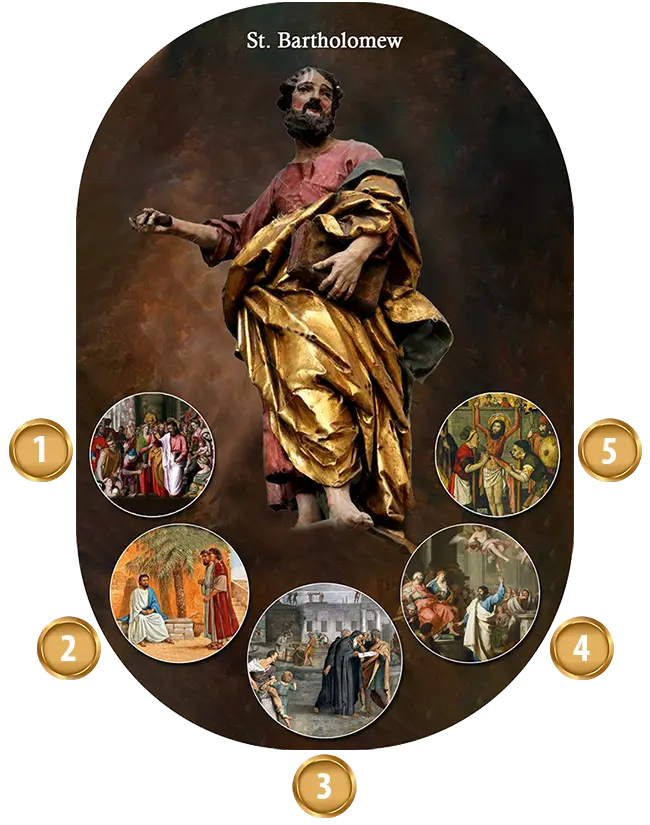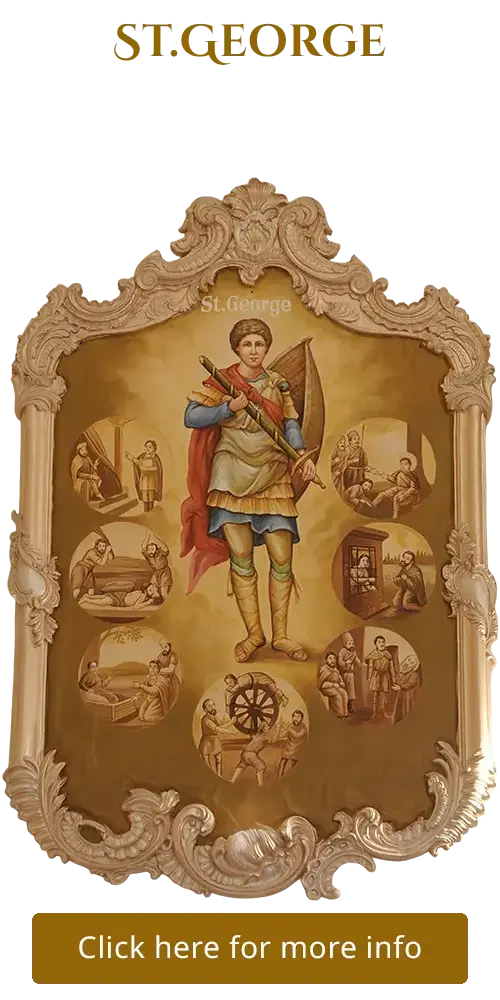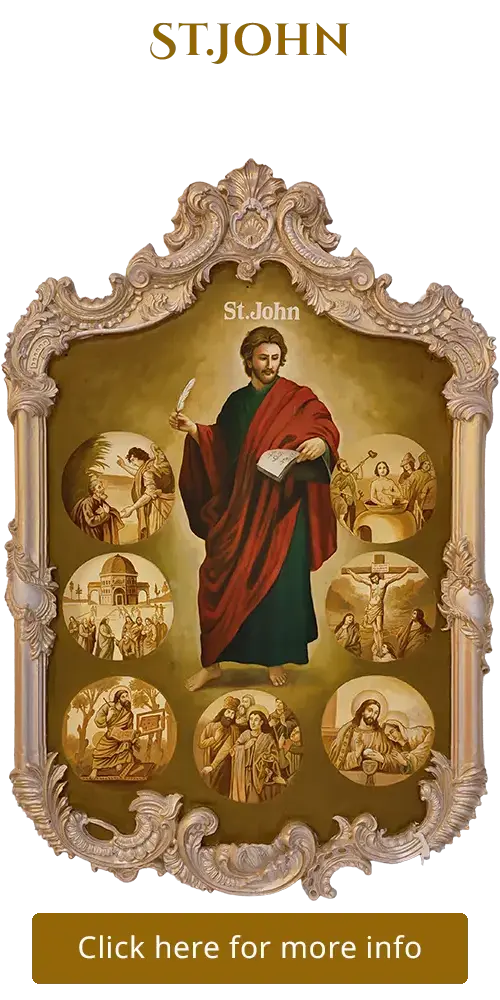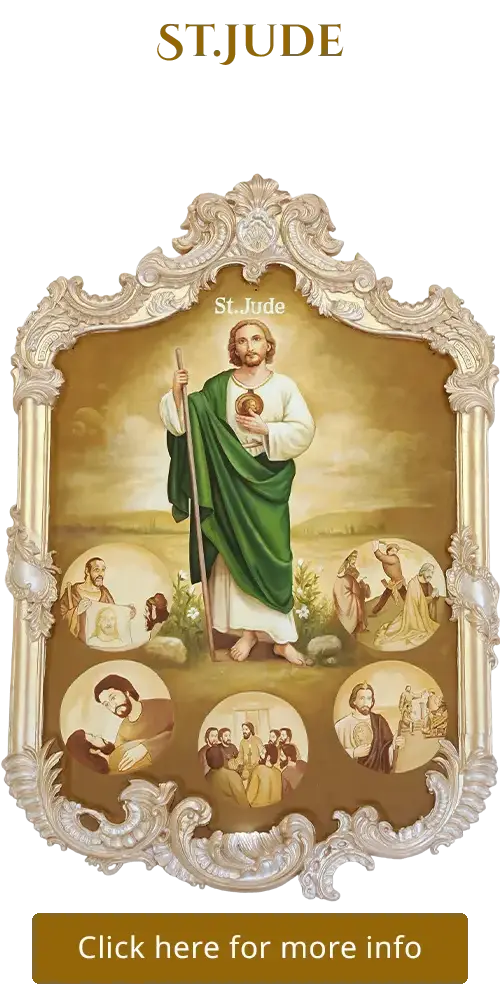St. Barthlomew
Inside Paintings - South Wall
St. Barthlomew



1. Missionary work
Historical Reference: Early Christian traditions and writings.
Description: An apostle of Jesus, Bartholomew is known for his missionary work and is often depicted with a knife, symbolizing his martyrdom (he was reportedly flayed alive). He is associated with various miracles, including healing the sick, casting out demons, and other acts of divine intervention.
Artists have frequently portrayed these miracles, with “Miracolo di San Bartolomeo” serving as a common title for such paintings. n this picture, famous artist Paolo Farinati created a piece titled “Miracolo di san Bartolomeo apostolo che libera un ossesso”, which depicts the apostle freeing someone possessed.
2. Call to Discipleship
Biblical reference: John 1:45-51
Description: Nathanael Bartholomew’s close friend, Philip, had just met Jesus and was struck with Jesus’ mysticism and goodness. Philip had complete confidence that Jesus was the Messiah. He ran to tell his friend Bartholomew – but Bartholomew, evidently a bit prejudiced, found it unbelievable that anyone of importance could come from Nazareth. However, when Bartholomew came face-to-face with Jesus himself, his heart quickly changed. Jesus’s first words about Bartholomew were peculiar: he called Bartholomew a “true Israelite with no duplicity.” Bartholomew’s nature evidently was clear and easy to read, lacking pretense and deceit. He spoke his true feelings.
Bartholomew then asked Jesus how he knew him. When Jesus replied that he had seen Bartholomew under a fig tree one day, Bartholomew’s whole countenance transformed. Jesus being from Nazareth no longer mattered; Bartholomew was ready to profess that Jesus was indeed the Son of God and the King of Israel.
3. Missionary work in Armenia, with St Jude Thaddeus
Historical Reference: Early Christian traditions and writings.
Description: With St. Jude, Bartholomew brought Christianity to Armenia, which became the first country in history to officially embrace Christianity in 301 AD. Both Bartholomew and Jude are considered patron saints of the Armenian Apostolic Church.
Surrounded by Islam on all sides Armenia has remained a Christian nation until this day.
4. Miracles and Conversion of King Polymius in Armenia
Historical Reference: Early Christian traditions and writings.
Description: Arriving at the capital of Armenia, Bartholomew entered the grand temple of the idol Asteroth where he found a great many blind, deaf, lame, and otherwise disabled persons, who were praying to this god to restore their health. Some were helped, others not. The devil, as he afterwards confessed, at the command of St. Bartholomew, had first, by witchcraft or other means, made these persons blind, deaf, or lame, and when they sought help in his temple, he destroyed the spell cast upon them, or used natural means to restore their health, while they believed that their god had helped them. Satan used also to speak by the image of this idol, and reply to those who questioned him. From the moment, however, when the Holy Apostle entered the temple, the devil had become silent, and answered not a word.
To the Armenians, this silence was incomprehensible; hence they asked the idol of another temple the reason of it. Satan, by the mouth of the image, said that Bartholomew, an Apostle of the true God, was the cause of it, and that the same would happen to him as soon as this Apostle should come into his temple. The idolatrous priest desired to know who this Apostle was, and by what means they could recognize him. Satan described him most minutely, adding that he prayed a hundred times during the day and as many times during the night. They immediately sought for St. Bartholomew, and found him just after he had delivered a man possessed of the devil; for Satan cried with a loud voice, that he was tormented by the prayers of St. Bartholomew, and forced to give way. After the idolaters had thus become acquainted with the Saint, they began to deliberate what they should do with him.
Meanwhile, Polymius, the king, whose daughter was also possessed by the Evil One, and who had heard of the deliverance of the one mentioned above, sent to the Apostle, humbly requesting him to come and free his daughter in a like manner. Bartholomew said a short prayer, after which he commanded Satan, in the name of Jesus Christ, to leave the body of the possessed, which was instantly done.
In the aftermath of this miracle, Bartholomew boldly declared that the gods worshipped by the king and his people were false, representing only “spirits of hell”. He then began to speak to the king and his courtiers about the one true God and the redemption of the world through the sufferings and death of God’s Son, Jesus Christ. To demonstrate the truth of his message, Bartholomew proposed to force the “devil himself,” who had spoken through their idol, to publicly confess the falsity of all false deities. Following these events, Bartholomew’s powerful preaching and demonstration of God’s power led King Polymius to convert to Christianity. He and Saint Jude Thaddeus are considered patrons of the Armenian Apostolic Church.
5. Martyrdom
Historical Reference: Early Christian traditions and writings.
Description: The glorious victory of Bartholomew in converting King Polymius and twelve principal cities of Armenia to Christianity, left only the idolatrous priests stubborn in their error, and as, after the downfall of their idols, they were despised and derided, they thought of means to revenge themselves on the holy Apostle. And when many plans had failed, they turned their eyes upon Astyages, a brother of King Polymius, who reigned over the other part of Armenia, and accused St. Bartholomew before him as an enemy and disturber of the land, who had even succeeded in seducing the king and the whole court, and who was intent upon entirely exterminating the ancient worship of the gods. Astyages, in whose weak mind idolatry had taken deep root, resolved to avenge the wrong which had been done to the gods. He called the holy Apostle to his court under the pretext of hearing his instructions. No sooner, however, had the holy man made his appearance, than the tyrant threatened him with the most cruel torments and the most terrible death, if he did not immediately sacrifice to the gods.
Bartholomew endeavored to convince him of the nothingness of his gods, but the tyrant would not listen, and commanded the executioners to seize the Saint, and tear the skin from his whole body, and thus slowly put him to death. The order was executed, and the holy Apostle was flayed alive. During this inhuman torture the Saint ceased not to praise God and to proclaim the true faith. God preserved his life miraculously until the skin was torn from his whole body, and as he still continued to declare the true God, the tyrant had him beheaded.
The holy body of the Martyr was placed by the Christians in a leaden coffin, and was buried with all due honors. In the course of time the pagans cast the leaden coffin with the relics of St. Bartholomew into the sea; but the waves miraculously supported it and carried it to the island of Lipari, the Christian inhabitants of which received the sacred deposit with joy, and placed it in a church erected for the purpose. Thence this sacred treasure was brought to Benevento, and finally, in the reign of Otho II., it was transported to Rome, where it is kept at this day in great honor.







